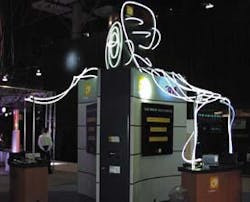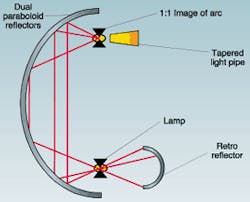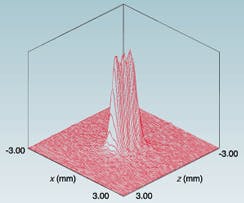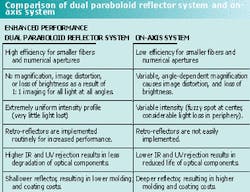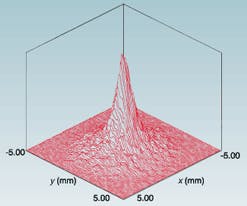New illumination platform expands application options
Kenneth Li
Dual paraboloid reflector system promises long transmissions with low drop-off, making more light and longer fibers possible.Illumination using fiberoptic technology has been in use for many years in a variety of applications including entertainment, industrial, and medical illumination. While improvement of the technology has slowed in recent years, a new system, called the dual paraboloid reflector system, has allowed fiberoptic illumination to be used in a broader range of applications (see Fig. 1).
The typical fiberoptic illumination system consists of a halogen or arc lamp focused into a fiberoptic bundle using on-axis elliptical or parabolic reflectors. The limiting factor in many systems has been the light collection and condensing mechanism of the illumination system. The problem is that the reflectors in such systems have an intrinsic brightness loss that causes the output brightness at the focus to be less than that of the source. The coupling efficiency of light into the fiber is thus reduced.
The efficiency of an optical system depends on the amount of light collected, which is a function of lamp arc length, reflector geometry, the area of the mirror array, and the cone angle (f/#) of the lens or lenses.1 To understand the relationship of these parameters on the lamp/reflector efficiency, it is useful to define the concept of etendue, which is also known as "optical extent" or the "optical invariant." Etendue is a measure of the area of the light distribution in an optical system, convolved with the solid angle of the light. When a well-corrected lens focuses a collimated beam to a spot, the area of the beam is reduced, but the divergence angle of the beam increases and etendue is preserved. The lamp/reflector combination has an etendue.
In fiberoptic illumination systems in which the output of the reflector is higher than that of the light sources, the small etendues required by smaller fiberoptics are often beyond the capability of the current on-axis illumination system. To overcome this limitation, some lamp manufacturers are developing lamps with smaller arc gapsin other words, smaller etenduesuch that the output etendue of the light condensed by the reflectors is small enough for efficient coupling into the fiberoptics. The reduction in arc-gap size, however, reduces the lifetime of the lamp and its intrinsic efficiency, which becomes the limiting factor of this approach.
An alternative approach
The dual paraboloid reflector system is an optical platform that captures the maximum amount of light and condenses it into the target, efficiently launching the light into the fiberoptics without any loss in brightness.
The system consists of two paraboloid reflectorsa portion of the first collects and collimates the light into parallel beams, which are directed to the second identically shaped paraboloid reflector (see Fig. 2). The second reflector refocuses the light onto a homogenizer, giving the beam a uniform intensity profile. The light emitted by the arc in the dual paraboloid system is reflected twice at the paraboloid reflectors before reaching the homogenizer. Hence, the infrared and ultraviolet rejection ratios are much higher than that of a single reflection in the on-axis system. The light source and target are located at the respective foci of the paraboloid reflectors, such that the optical flux from the source is imaged to the target with minimal distortion and unit magnification. The result is 1:1 imaging with a uniform intensity profile (see Fig. 3). The dual paraboloid system preserves brightness from arc to target, increasing the overall system performance.
In contrast, the single reflector in an on-axis system diminishes brightness when coupled to a small fiberoptic, decreasing both efficiency and performance. The light reflected at different angles from the elliptical reflector is magnified to a variable degree, causing image distortion and a "fuzzy spot" at the target.
A comparison of intensity profiles shows how much light is lost (represented by the sloping sides at the base of the line profile) in the on-axis system in comparison to the dual paraboloid system (see Fig. 4). The rectangular tapered light pipe (TLP) in the dual paraboloid system delivers light of extremely uniform intensity. It also transforms the light at the input with high numerical aperture (NA) to a lower NA at the output of the TLP. When the light is coupled into the fiberoptic, the light is more uniform along the length in side-lighting fiber, and more light is available from end-lighting fibers. The output at the end of the TLP is also uniform in intensity, which couples the maximum amount of light into low-temperature-threshold plastic fibers without fiber damage.
Using a dual paraboloid reflector system, the combination of low NA (between 0.3 and 0.4), high light-capture efficiency, and a homogenous light distribution across the diameter of the fiber face allow better performance characteristics from multifiber and large-core fiberoptics than from traditional neon lights. Because of the low NA, the drop-off in brightness along the length of the fiber is minimized in both solid core and multi-fiber applications. In addition, the color of the fiber output can be changed by a color wheel inside the illuminator, in contrast to the single color emitted by neon.
New frontiers for fiberoptics
The movie industry has a new interest in applications for fiberoptics because of a significant increase in fiber brightness performance. Recent Stephen Spielberg films including Artificial Intelligence and the soon-to-be-released Minority Report have benefited from the new performance capability of dual parabolic reflecting platforms. The large-core fiberoptic and multi-fiber bundles, when powered by dual parabolic illuminators, impressed lighting directors, particularly the multicolor capability of the color wheel and the simple installation and flexibility of multiple and solid-core plastic fiber. Safety on the movie set is improved because of the reduced use of neon with the fiberoptic substitute.
The ease of setup and tear-down makes the technology useful for other entertainment industry applications such as signage and lighting for cruise lines, gaming, casino amusement parks, concerts, road shows, and conventions. In the architectural lighting field, there are many possible uses, such as outlining buildings, retail-store lighting, fountain lighting, and other wet applications. In the medical field, surgical headlights, endoscopes, and microscope illumination benefit from the technology. And the no-heat aspect of fiberoptic technology gives it a definitive advantage for petroleum and other high-flammability applications.
In dual paraboloid reflector systems, the overall power conversion from electrical to optical energy is so high that they are more energy efficient than traditional light systems using tungsten or halogen lamps. An illuminator with multiple outputs can be used to replace multiple spotlight systems. Indoor lighting, merchandise cases, and department-store lighting benefit from efficient illumination. Remote illumination systems using longer fibers can be applied to applications such as cleanroom lighting, street lighting, and theme-park lighting, where lamps can be changed remotely without disturbing the illuminated areas. For safety reasons, remote lighting is also applicable to swimming pools, fountains, and explosion hazard areas, in which the electrical components are located at a distance from the illuminated areas.
REFERENCE
- L. J. Hornbeck, Elect. Imaging EI 97, Projection Displays III (February 1997).
KENNETH LI is vice president and chief technology officer at Wavien Inc., 26145 Technology Drive, Santa Clarita, CA 91355; e-mail: [email protected].

